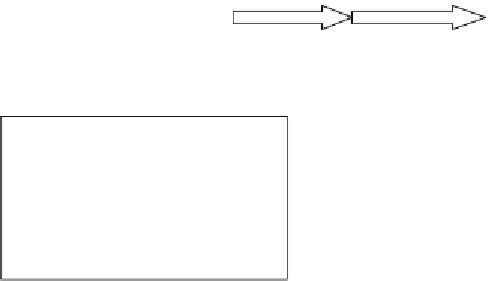Geoscience Reference
In-Depth Information
organisation are essential for reduction of failure costs, and that the investment to
realise these conditions is not more than 10% of the average failure costs.
Any risk assessment can only be effective, when truly integrated in the entire
design and construction process. Still, too often, risk assessment is a rather isolated
and spur-of-the-moment exercise, performed by highly specialised professionals
during the design phase, for instance. This situation limits the positive impact that
risk assessment could have on the final project result, in terms of reliability, safety,
and functionality, with acceptable costs and within a reasonable project planning.
Before introducing a flexible and proven risk management process approach, the
terms risk and risk management require some attention. A generic definition of the
term risk is the product of the likelihood of occurrence of an event and the
consequences of that event. Normally these events are hazards, with the potential to
have negative effects. Here, risk is considered by definition as potentially harmful
(or profitable). Risk management can be simply defined as the overall application
of policies, processes and practices dealing with risk. Fig 8.11 presents
schematically an example of a structured risk management process approach, the
GeoQ approach. It is based on three pillars: (1) a cyclic procedure during
construction, (2) proper-in-time data availability in all construction phases, and (3)
continuity and transparency of data (particularly the 'soft' data).
The transparant and flexible GeoQ risk management process aims to assure the
overall quality of a project, by risk management of ground behaviour in relation to
design, construction, operation and maintenance activities. In addition, the risk-
driven GeoQ process reveals the need for timely and adequate site characterisation,
appropriate design adjustments and effective monitoring. These activities are easily
underestimated and often under severe attack by today's business pressures of
lowest cost and shortest construction time. The GeoQ approach provides an
adaptive framework for managing the risky ground during all phases of a
construction project, from the early feasibility phase through to the maintenance
phase. A tedious process, but it pays, because uncertainty in soil behaviour is a
dominant factor in construction and maintenance.
feasibility
pre-design
design
contracting
construction
maintenance
GeoQ steps:
1. gathering information
2. identifying risks
3. classifying risks
4. remediating risks
5. evaluating remaining risks
6.
filing in risk register
Figure 8.11 The GeoQ risk management process
The GeoQ process consists of six specific risk management steps, which ideally
should repeat as a cyclic process in each phase of the project (Fig 8.11)









Search WWH ::

Custom Search